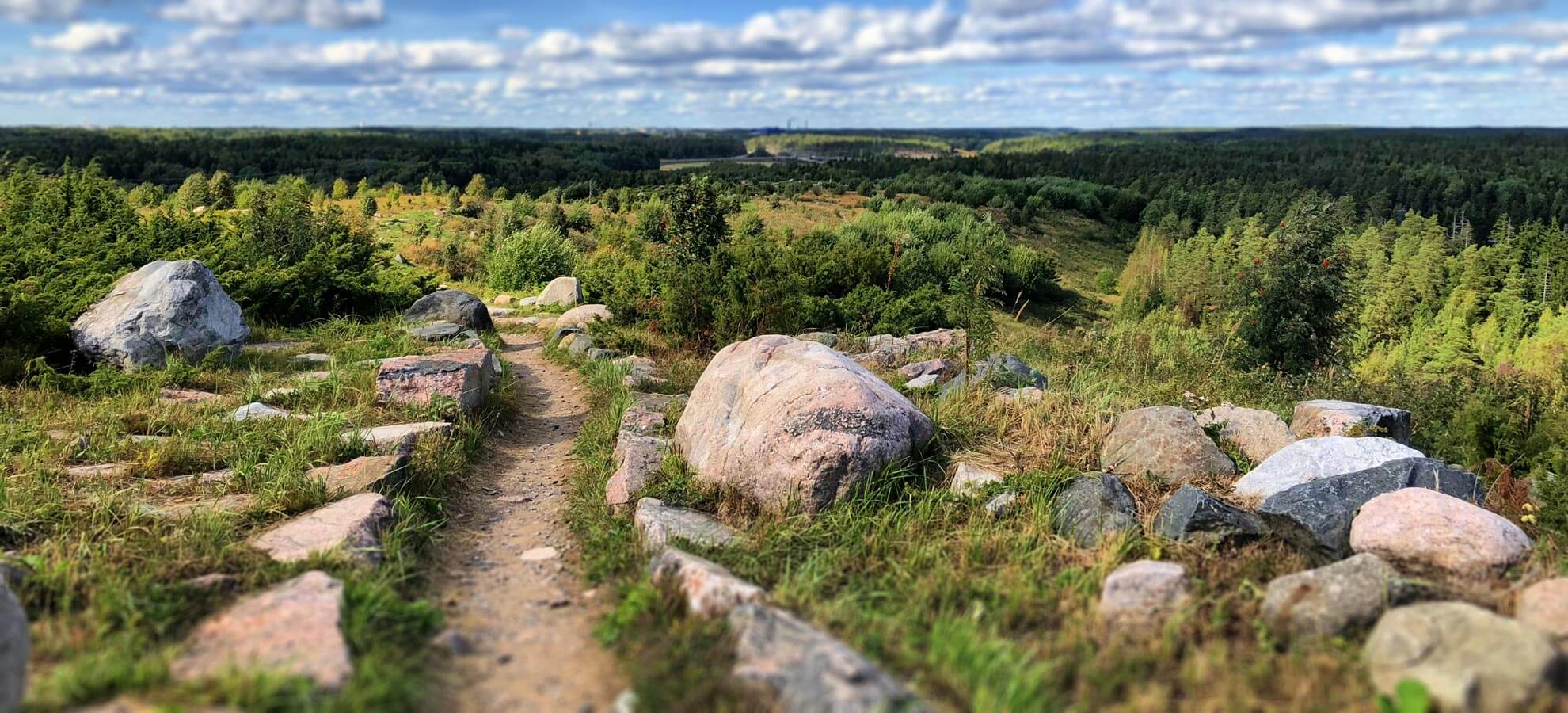Vuosaari hill has been built as a comfortable outdoor area and natural oasis. The recreational area is 95 hectares in size.
There are plenty of routes for hikers of all levels, from easy-to-walk service roads to rocky little paths. Some of the routes provided with signs are difficult to walk in places. Using pushchairs on the paths is not recommended. There is no winter maintenance in the area.
In connection with the main entrance, there are two guide containers that provide information about the place.
Nature trail calling
Explore the special nature of Vuosaari hill on two nature trails with a total of 13 nature information boards. A large number of city employees have been involved in building Vuosaari hill. The development of the landscape and nature has been particularly influenced by nature gardener Jukka Toivonen and soil expert Pirjo Laulumaa.
The nature trails are located in the eastern part of Vuosaari hill, in the soil fill area. The nature trails begin and end at the same point below the pass. There are signs from the main entrance to sign 1 of the nature trails, which is 800 metres away. Cycling is forbidden on the nature trails.
On Jukka’s Trail, nature signs 1–8 (1.3 km), you can admire the expansive view from the highest point of Vuosaari hill, but also dive into the shadow of the groves. The route has significant differences in altitude, and the paths are steep and rocky in places.
Jukka’s Trail, nature signs 1–8
-
1 Kingdom of stones
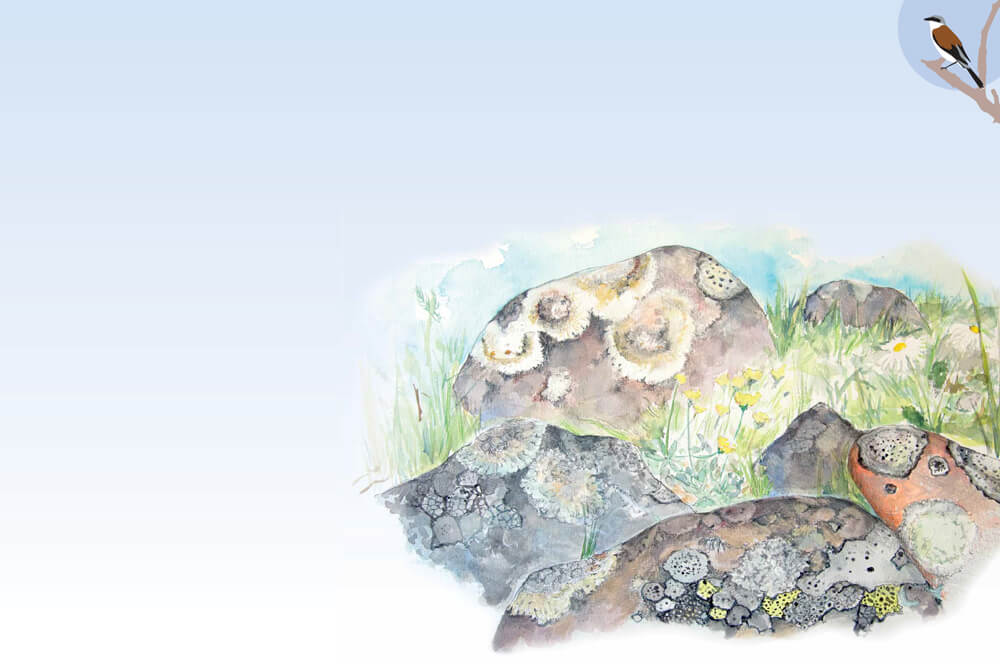
The rehabilitation of the landfill site and the landscaping of the soil fill area have resulted in a new recreational area for everyone to enjoy. A special feature of the area is the naturally evolving nature, the framework for which has been created by humans through structures and plantations.
You can admire the diversity of natural stones in various parts of Vuosaari hill. The colour and structure of stones have been modified by their formation process. Stones rescued during earth construction at Vuosaari hill have been reused. Large loose rocks have been placed naturally in the environment. Over time, the rocks will be covered in lichen and moss if they are not trampled on. The lichen species are different on acidic and alkaline rocks.
In front of you is an artificial pass made of natural stones with a wall height of more than three metres. (Note: For admiration only – the wall cannot withstand climbing.) The southern, shadowy wall is cool, while the sunny side warms up very much. In the summer months, the temperature difference can be as high as 30°C. On hot days, you can notice the cooling shadow on your skin. The vegetation differs greatly: ferns and tall plants live in the shade, whereas vegetation on the sunny side is sparser and lower.
-
2 Human creation
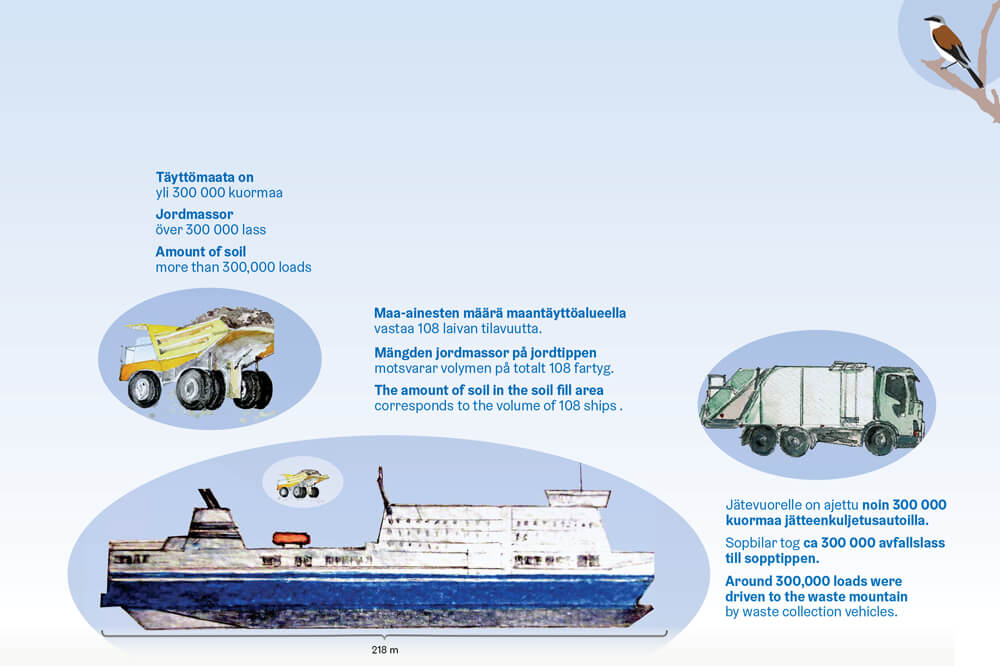
In front of you lies more than three million tonnes of mixed waste from 1966 to 1988. At that time, waste was mainly sorted to separate out paper and later also glass. This is why most of the waste ended up in a landfill. The waste mountain is covered with tight structural layers and is no longer harmful to the environment. After the rehabilitation of the landfill site (2012–2020), the current topsoil has become a green meadow in a couple of years.
Underneath your feet is a soil fill area where clean surplus soil has been brought in. This is the result of earth construction, where the foundations for buildings have been excavated. Fine-textured soil cannot be exploited in the construction of roads, for example, because it is affected by frost heave. This is why it had to be transported to the soil fill area. Around 5 million cubic metres of soil were brought here by earth movers and lorries. This amount corresponds to more than 300,000 earth mover loads.
-
3 Lovely heat!
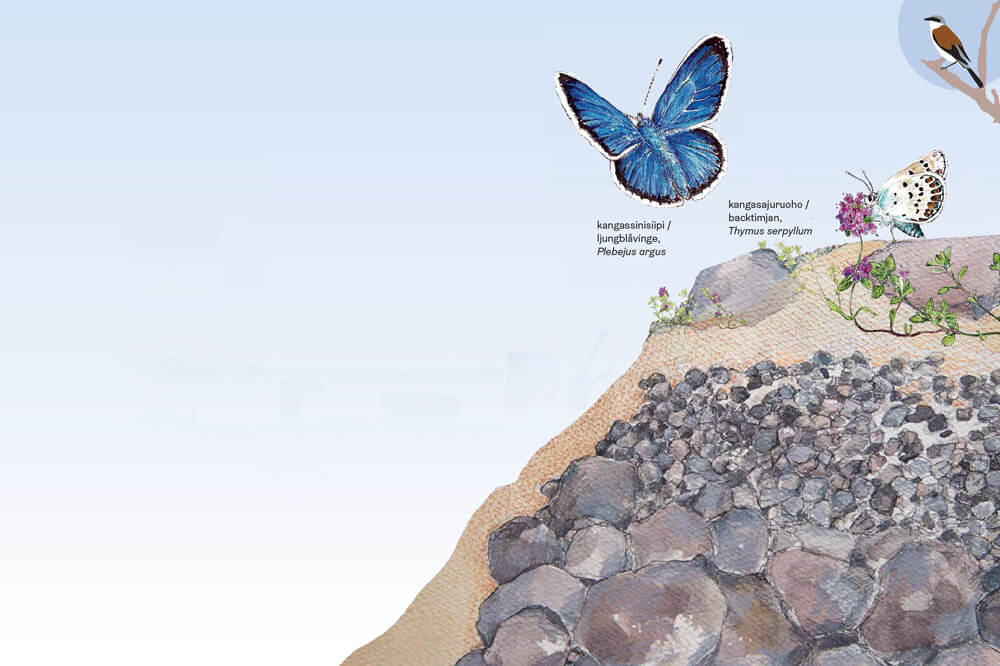
Since the end of pasturing and the effective extinguishment of forest fires, xerothermic (hot and dry) grasslands have become endangered. This xerothermic habitat has been built imitating a ridge.
The imitated ridge has three different structural layers made on top of the soil fill hill. There are large rocks at the bottom, then coarse gravel, and stones and sand at the top. Water quickly penetrates into coarse ground, and therefore xerothermic habitats are dry. They are even drier when located on a southern hill in a windy and sunny place. The species of xerothermic habitats are specialised in extreme conditions in which conventional species cannot survive.
Wild thyme has been planted in the xerothermic habitat, an important plant for many endangered insects. Wild thyme blooms in the middle of summer. With luck, you may notice a buzzing bumblebee or a slender blue butterfly looking for nectar.
-
4 Rescue operation
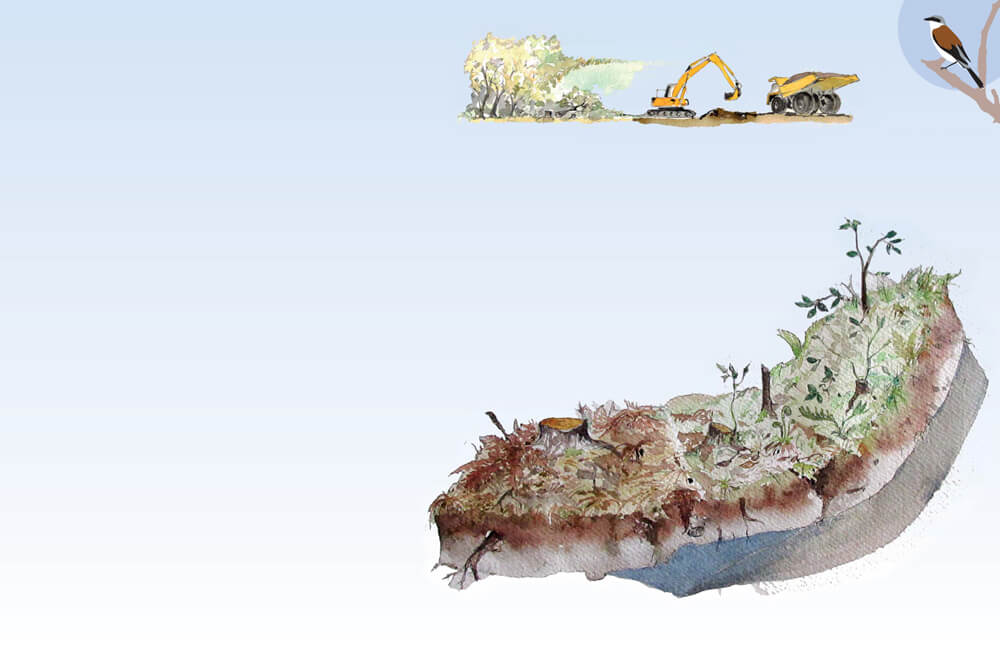
At the end of Niinilahti Bay, south-east of Vuosaari hill, there was still a rare waterfront grove with alder and ash in 2002. The existence of the grove was threatened by the construction of Vuosaari Harbour, until Jukka Toivonen and Pirjo Laulumaa, who were responsible for landscaping the soil fill area, came up with a rescue operation for it.
The slopes around this sign guide the rainwater into the valley. The place was perfect for the waterfront grove, which needed a new home. First, the ground was lined with a one-metre layer of clay soil, which holds water. After that, soil from the Niinilahti grove was carefully moved here to make way for the construction of Vuosaari Harbour. The soil was cut into slabs in winter 2003 and lifted into earth movers. After transportation, the slabs were positioned here with the root side down. They included stumps and roots of small broadleaf trees.
A new grove has gradually emerged from the transferred soil, stumps and pieces of roots. The grove has been allowed to develop in peace without any forestry measures. There now grows ash and alder, bird cherry with white flowers, and the undergrowth includes nettle, common reed and yellow meadow-rue.
-
5 Hazel path
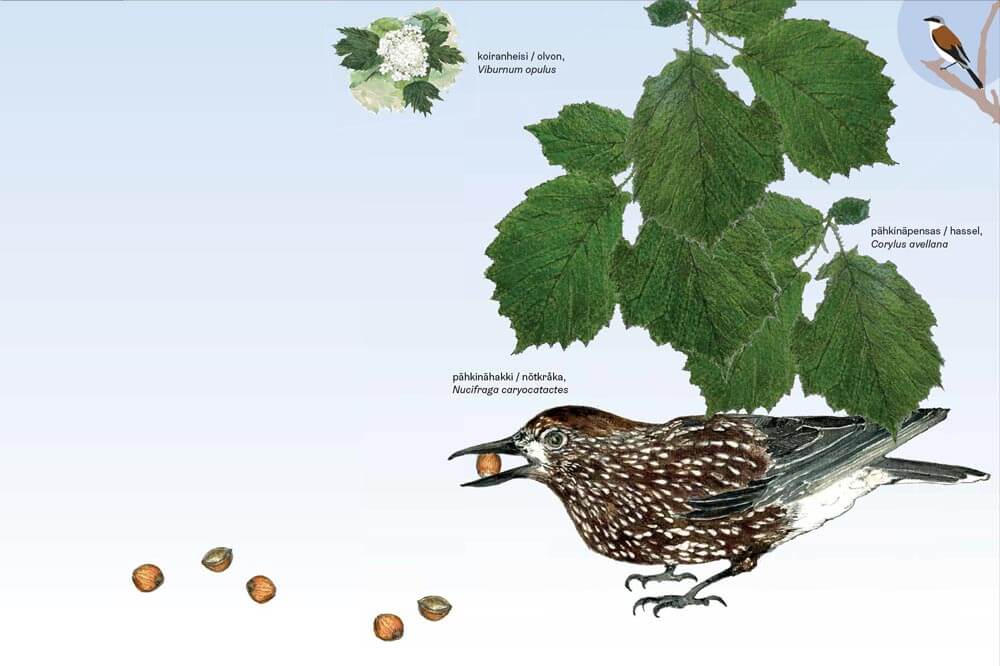
A vault made up of common hazel plants creates a fabulous atmosphere for an unhurried hiker. The narrow hazel grove was planted in mineral soil transported from Käärmeniemi and Lehdessaari island. In the spring, the wood anemones that were moved there bloom on the slope. Early in the summer, you can enjoy the white flowers of wild roses and guelder roses. The red berries of buckthorn and guelder rose glow in the autumn. All the shrubs in the area have been obtained from nurseries, but they have since been allowed to reproduce naturally.
In the autumn, wandering spotted nutcrackers will surely find delicious nuts from the hazel grove. They scour all the bushes before they move to the next rest stop. The spotted nutcracker stores nuts in many places and will find them later thanks to its good memory. With the help of the nutcracker, common hazel gets a free ride to new places of growth. Nuts sprout into new plants if they do not get eaten.
-
6 Hiding place
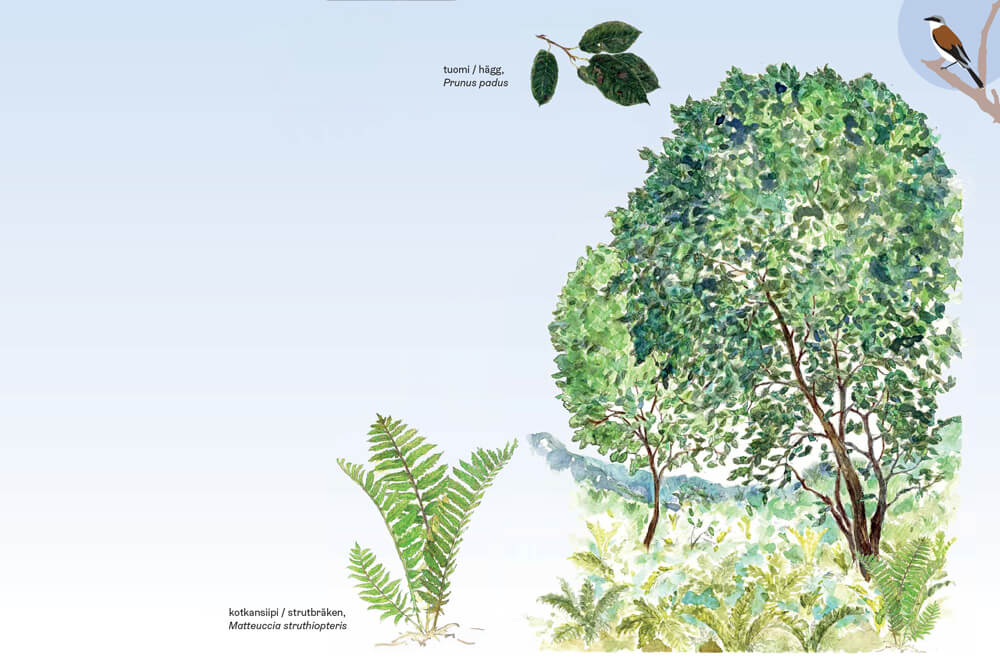
The brilliant fern grove is surrounded by steep edges built from a rocky shoulder. The whole soil fill area has been made according to the same principle in order to keep the fine soil in place. This pit was originally intended to be filled with soil excavated to make way for the harbour. Instead of filling the pit entirely with soil, a suitable amount of soil was brought into the pit for a sheltered grove. The base was filled with fine-grained mineral soil and the topsoil was made of leaf compost. A curious fox participated in the construction work, supervising the work and checking the outcome by sleeping on the dark soil.
The trees have grown in the grove since 2009, when construction was completed. The fertile soil has been planted with alder, bird cherry and some common hazel plants. The goat willow trees have arrived by themselves. In the shadow of the trees grow the handsome ferns, which survived the early years without shelter from the sun.
The grove is home to birds that nest in broadleaf forests, such as the common blackbird, Eurasian blackcap, great tit and common chaffinch. Brown hares and roe deer seek food and shelter in the grove. It is often windless at the bottom of the fern grove, even if the meadows are buffeted by sea wind.
-
7 Do you recognise the landmarks?
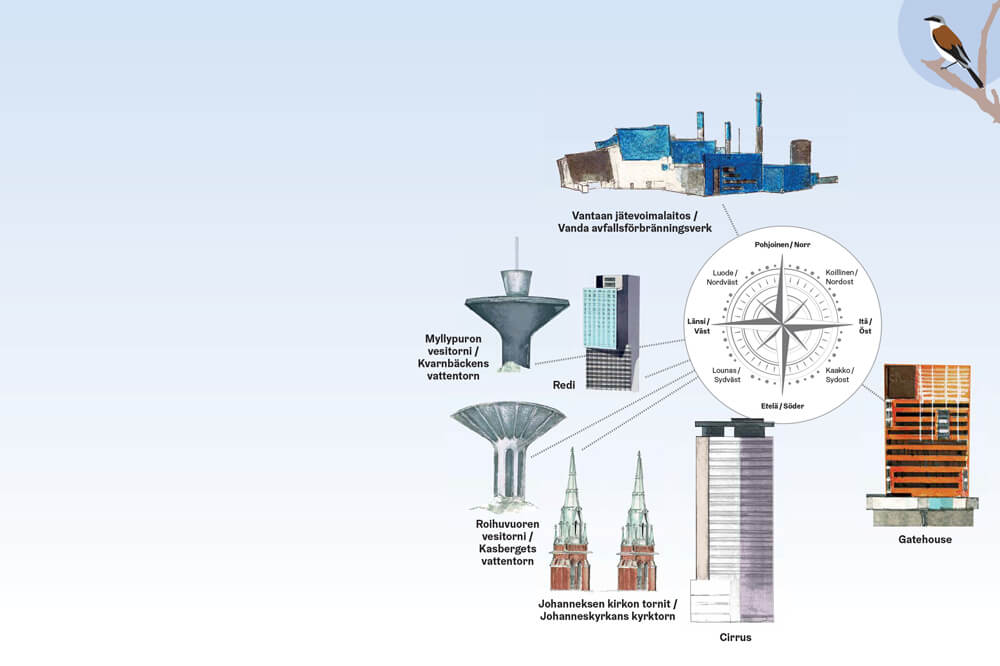
The highest point of Vuosaari rises to 60 metres above sea level. This height was reached with the landscaping work in 2010–2012. The wind and sun dry the soil and vegetation at the top, which is why only resistant species like it here. The groves below are lush oases compared to the treeless top.
Can you establish the compass points from the top in sunny weather? To help you, you can look at the landmarks in the horizon and the accompanying compass. Approximately in the north, you can see the chimney of the Vantaa waste-to-energy plant, and in the south, the Vuosaari Cirrus tower block, which reaches the height of 87.5 metres. If you look over the harbour into the archipelago, you can see many islands, the closest of which are Mölandet and, in front of the harbour, further away, Musta Hevonen. In clear weather, you can see as far as the church towers in the centre of Helsinki (14 km) in the west. In the east, you can see the chimneys of the Kilpilahti oil refinery in Porvoo (22 km).
-
8 Spiky little tree
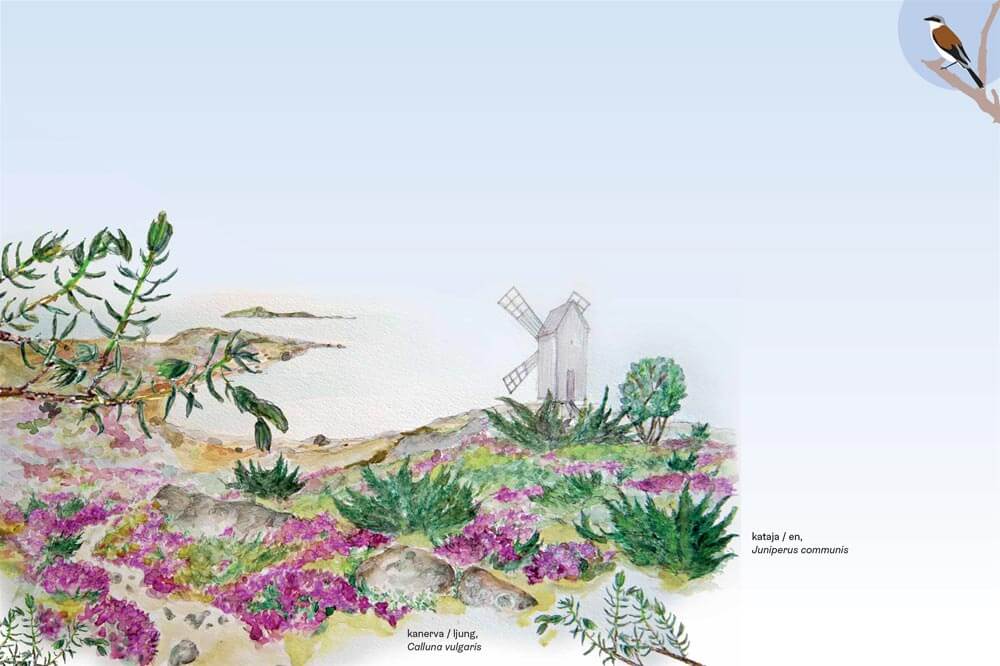
The official plant of Vuosaari hill could very well be the diverse juniper. Over the years, thousands of junipers have been planted in the area. The juniper heaths were inspired by the Jurmo ridge island in the Archipelago Sea. The vast island is full of low junipers and heather as far as the eye can see.
Juniper is a bush or a small tree that likes the sun. Juniper is dioecious, which means that each plant is either female or male. Only female plants have seed cones, which look like berries. The berries can be used to flavour game dishes.
The mother plants of Vuosaari hill’s junipers were harvested in nature in various parts of Finland for cultivation in the Hongisto nursery. The varieties represent the natural types of juniper. A low-to-the-ground juniper was named the Vuosaari hill variety. Fan-shaped junipers were named after national heroes Lotta Svärd and Sven Dufva. Varieties of juniper that grow straight up are Jaakko Ilkka, Sisu and Urho, also names from Finland’s history.
On Pirjo’s Path, nature signs 9–13 (1.1 km), you can enjoy the impressive pass and flowering meadows. The route is fairly even and easy to walk.
Pirjo’s Path, nature signs 9–13
-
9 Skilful flyers
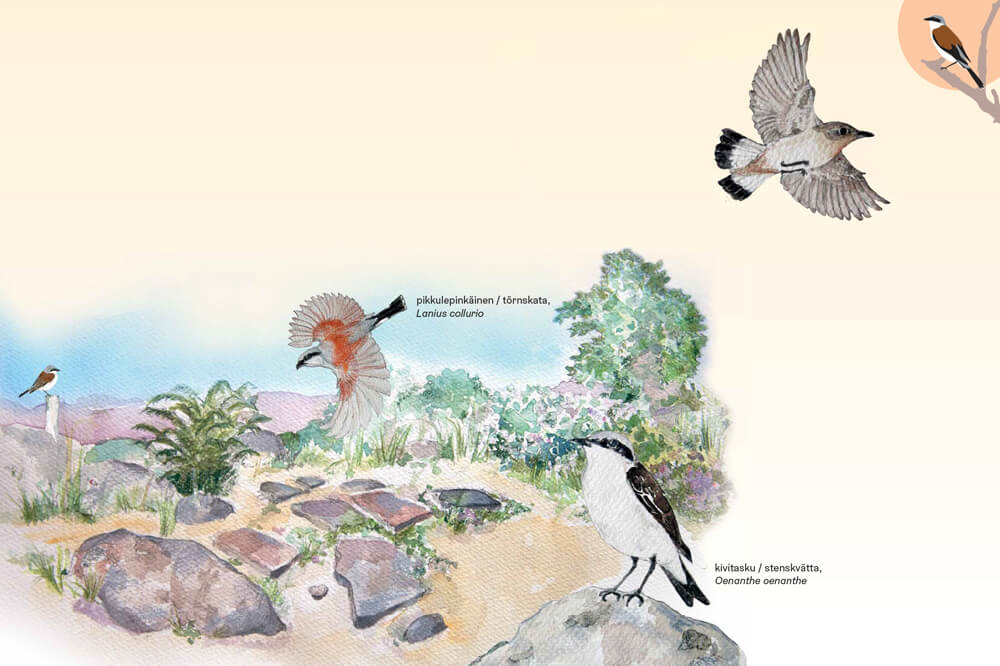
Bird watching is interesting at all times of the year, as many activities of birds can be seen or heard. Are there males singing love songs for females, mothers feeding their nestlings or large flocks taking a break from migrating?
The range of Vuosaari hill’s habitats maintains diverse birdlife. The number of nesting species varied between 27 and 35 in 2012–2019. The area is particularly attractive to open-land birds that enjoy meadows, rocks or semi-open shrubs. Easily recognisable in appearance, the northern wheatear wags its tail and makes sharp warning sounds. A keen eye can spot the official bird of Vuosaari hill, the red-backed shrike, in a rose bush or dead pine looking for prey.
Humans are visitors to the area, but for birds and many animals, Vuosaari hill is home. People are therefore advised to follow only marked paths, especially in spring and early summer, the most sensitive period for nesting birds.
-
10 Intoxicating scents
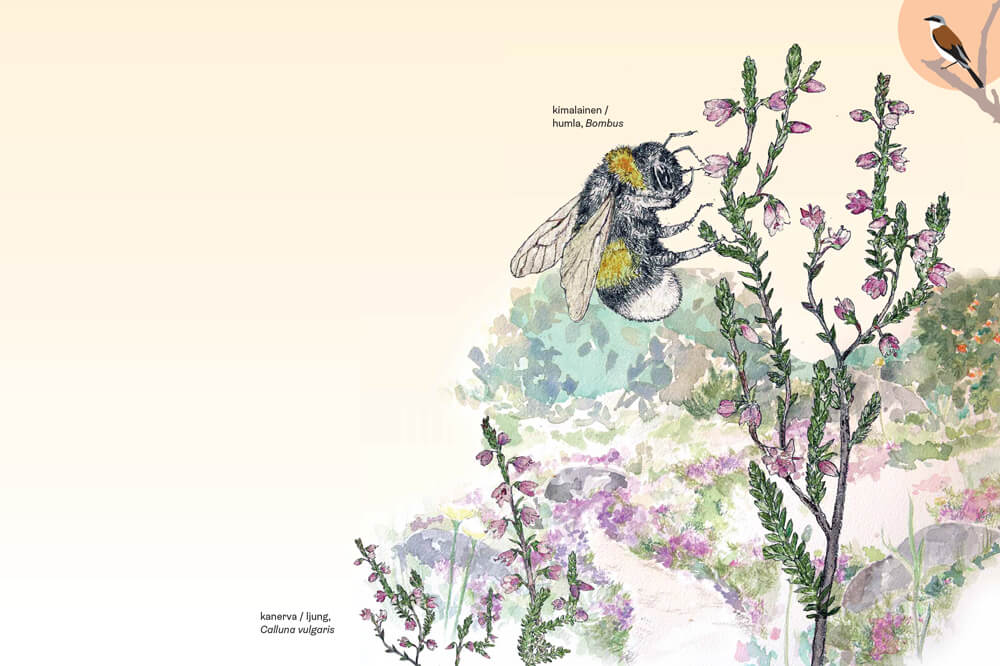
In the scented meadow, you can retreat into a miniature world of your own, somewhat protected from the wind. The small banks and the shrubs growing on them create a finite habitat in the otherwise open landscape.
Throughout the summer, you can smell the spicy scent of wild thyme and heather. Delicate pink heather flowers can be admired in the middle or late summer. Both plants are very good nectar producers and are therefore important for pollinators. You may see or hear these pollinating insects, such as bumblebees and butterflies, if you remain stationary for a while.
The “father” of the place, nature gardener Jukka Toivonen, had the key idea to choose structures and plants that increase biodiversity, such as domestic nectar plants. Therefore, Vuosaari hill has heaps of rocks for northern wheatears and snakes, as well as hot and sunny environments for insects. Bare areas have been made for larks, and roses have been planted to produce hips for small birds.
-
11 Life in a pile of rocks
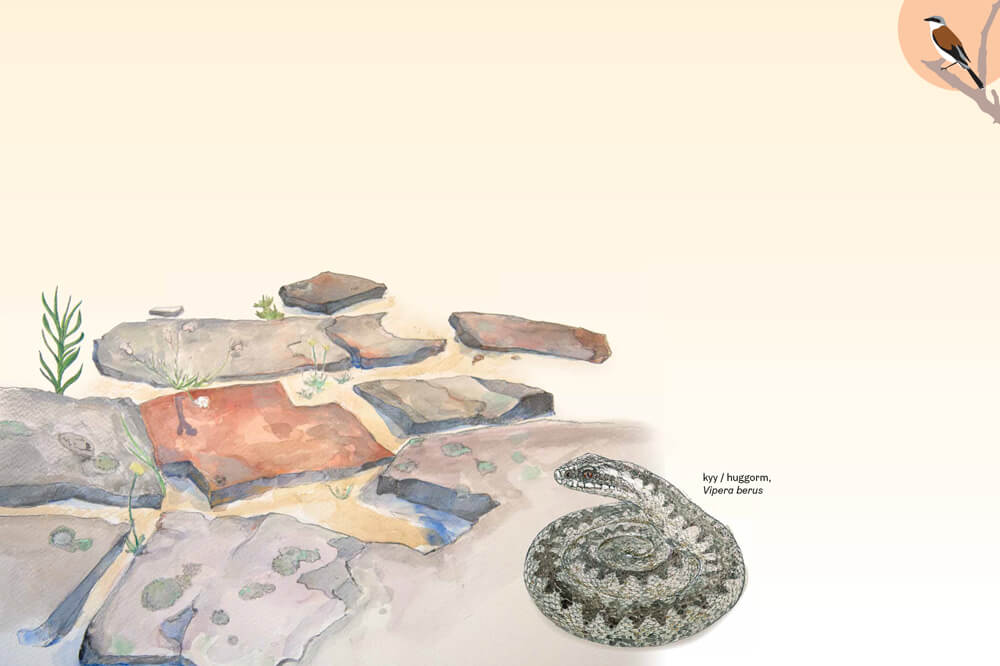
The small rocky knoll is Vuosaari hill’s first slate area, which was built in 2003. The purpose was to imitate the conditions of natural bare rock. There are large pieces of rock beneath the flat field stones.
It was later discovered that the deep rock cavities may provide wintering places suitable for snakes. Snakes need new hiding places as the city expands. Versatile landscaping can help these troubled reptiles. Snakes eat small rodents – moles and mice, which serve as intermediate hosts for ticks. Snakes indirectly reduce the incidence of tick-borne diseases, such as Lyme disease and tick-borne encephalitis.
Over the years, birdwatchers on the ridge have seen many rare birds glide by, either close by or high in the air. Visibility from the high ridge is good in all directions. The best time to see migrating birds is in April and May and from August to December.
-
12 Memories of the past, reproduced…
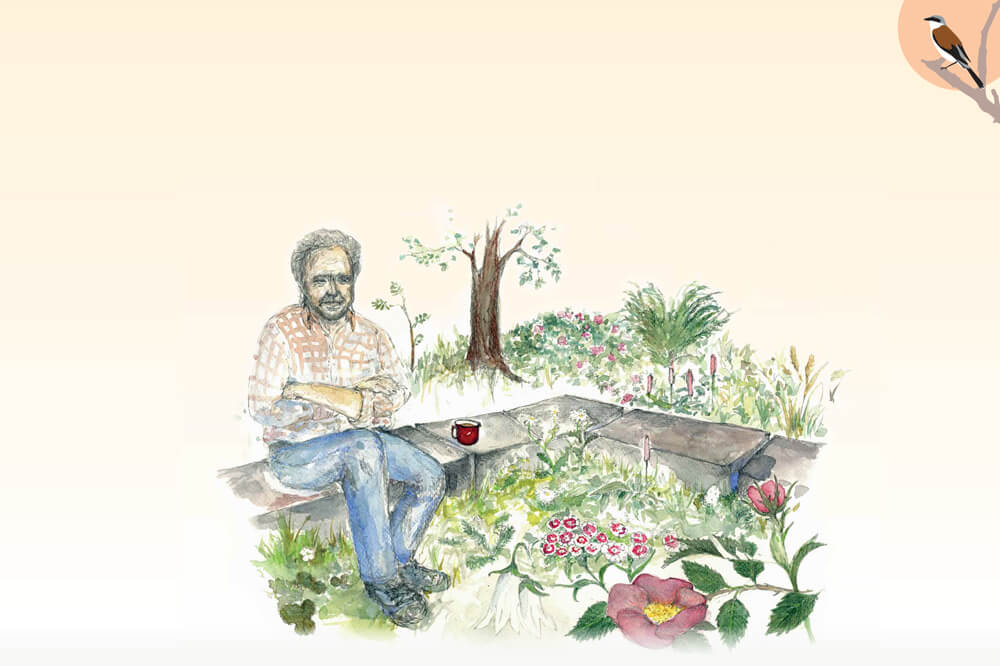
Behind the handsome stone wall is a garden with the built-up ruins of a house, reminiscent of Vuosaari’s former country landscape. Traditional horticultural plants grow inside the “foundations”, as if to commemorate the past. Can you find a big-leaved musk strawberry or a yellow-flowered spurge? The garden and the stone wall flourish throughout the summer because many species of traditional perennial plants have been planted. All the grassy plants in the garden were purchased at the Annala garden in Vanhakaupunki, Helsinki.
Jukka Toivonen, who created the vision for Vuosaari hill, saved two apple trees and a blackcurrant bush when they were almost devoured by an earth mover during the early stages of the landfill rehabilitation. He moved them and planted them in the courtyard, after which they have started to grow again. However, brown hares like to graze the bark of the apple trees, giving them a peculiar shape. The trees may sometimes be in rather poor condition after being gnawed at in the winter. The number of brown hares in Vuosaarenhuippu has increased with the growth of shrubbery.
-
13 Disappearing diversity
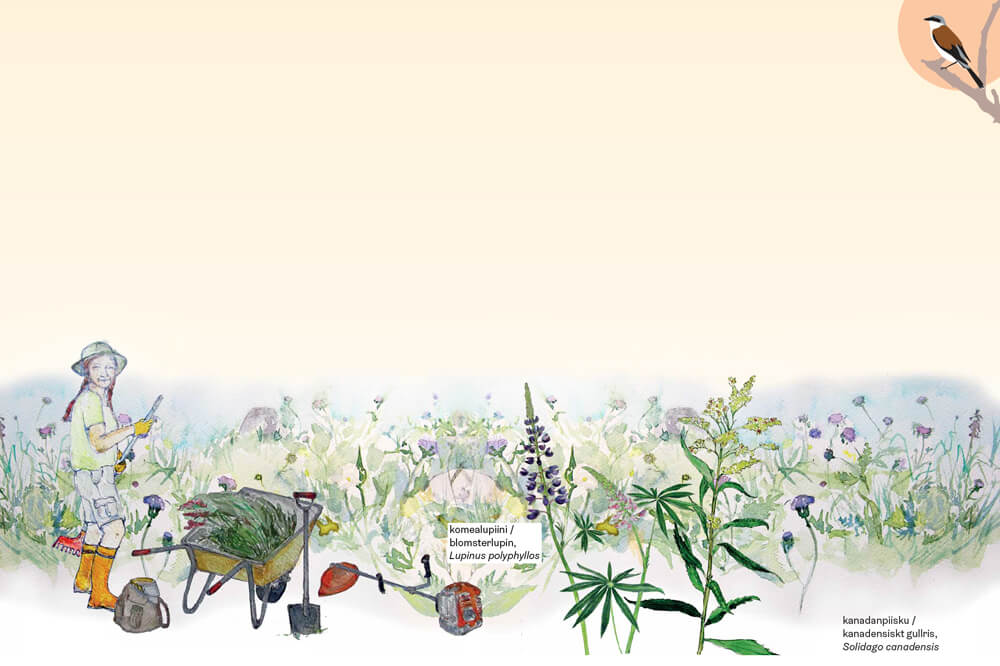
Vuosaari hill’s open meadow landscape is the result of long-term and continuous care. For the first time, a meadow was created using the green construction method of layered excavation, which, after this experiment, was also used elsewhere at Vuosaari hill. The topsoil was peeled off at the construction site one ground layer at a time, moved to Vuosaarenhuippu and distributed in the same order to this site. The finished soil has been sown with plants such as yellow bedstraw, field scabious and Nottingham catchfly. Common kidneyvetch has spread from the topsoil’s seed bank.
The great structural change of Finnish agriculture has brought an end to traditional pasturing, mowing and slash-and-burning. Animals now graze on grassland, not on natural pastures. For this reason, all our traditional landscapes are under threat and their species are in danger of extinction. Anything may emerge from the slowly settling soil – invasive alien species and tall, fast-growing plants. These quickly take up living space from blooming grasses, which are less tolerant of competition. The Vuosaari hill management team mows the plants of this meadow every year and removes the mowing waste. The management of Vuosaari hill’s meadows reduces the plight of meadow species, at least locally.
Golden rules for a responsible hiker
- You can walk and run on marked paths, but cycling is not suitable for the area. You can lock up your bike in the bicycle rack by the main entrance.
- Please stay on the paths for your own safety. The terrain includes many rocks, rotten stumps and thorny roses.
- Walk carefully, since there are rocks and loose sand on the paths, and rain may make the ground slippery. There is no winter maintenance. The paths are not suitable for pushchairs.
- Please let plants and bushes grow wild and free for everyone’s pleasure!
- Leave the berries and fruit primarily to the birds and insects – children can sometimes have a taste. In several years, there have been enough raspberries to pick!
- Take your litter to the waste bins by the main entrance or take it home with you.
- Beware of steep slopes – the rocks and edges may collapse.
- The area is inhabited by adders and ground wasps. Watch your surroundings and be careful.
- Do a tick check at home at the latest!

